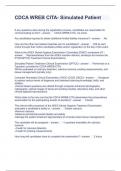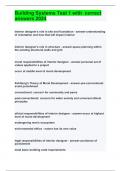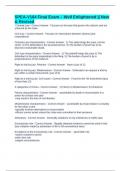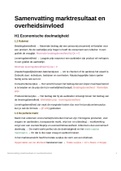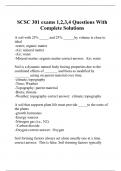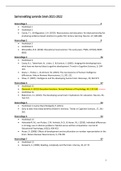Mandatory articles International Business Context (IBC)
Topic 1 – Internalization Topic 2 – Institution
Article Page Article Page
1.1 – Buckley et al., 1976 2 2.1 – North, 1991 10
1.2 – Narula et al., 2019 5 2.2 – Hall & Soskice, 2001 12
1.3 – Dunning, 1980 8 2.3 – Berry et al., 2010 16
Topic 3 – Culture Topic 4 – Corporate governance
Article Page Article Page
3.1 – Voss et al., 2014 18 4.1 – Aguilera & Jackson, 2003 25
3.2 – Chiu & Hong, 2007 20 4.2 – Oliver, 1991 29
3.3 – Sarala & Vaara, 2010 22 4.3 – Haxhi & Aguilera, 2017 32
Cases
Article Page
1.4 – Casadesus-Masanell & Ricart, 2011 36
2.4 – Mintzberg, 1996 38
3.4 – Ghemawat & Altman, 2016 40
4.4 – Subramanian, 2015 42
,1.1 – Buckley et al., 1976
A long-run theory of the multinational enterprise
1. What is the main idea of the article?
→ Abstract – Introduction – Conclusion
The main idea of Buckley et al. (1976) is that it describes the link between the internalization and
internationalization (becoming an MNE) of the firm and the growth of multinationality. The first can
be referred to as vertical integrated producer and the latter to integration of production. According to
the authors, a market in an intermediate good will be internalized if the benefits outweigh the costs.
The benefits stem from market imperfections. According to Buckley et al. (1976) there are four groups
of factors that are relevant to the internalization decision: (1) industry-specific, (2) region-specific, (3)
nation-specific, and (4) firm-specific factors. The main emphasis in this article is on the industry-specific
factors.
2. What is the context and goal of this study?
→ Assumptions
There is no established theory of MNE’s. This is mainly because of the orthodox theories of production
and trade. The orthodox theory have two key assumptions: profit-maximization and perfect
competition. These are not adequate and previous theories of MNE’s have tried to replace this
orthodox theory by relaxing one of the two assumptions: profit-maximization → alternative
managerial goals, and perfect competition → allow monopoly/oligopoly. This paper supports the
second approach more than the first. It differs however from the second approach as it concentrates
on imperfections in intermediate-product markets (e.g. intellectual property) rather than in final-
product markets (e.g. marketing, R&D, management). This relates to the transaction cost theory.
3. Type of research and methodology
→ Type of paper: founding piece/key development/review and future research/empirical tests
→ Methodology
Founding piece.
The theory is based on three assumptions:
1. Firms maximize profit in a world of imperfect markets.
2. When markets in intermediate products are imperfect, there is an incentive to bypass them
by creating internal markets. This involves bringing activities that are linked by the market
under common ownership and control.
3. Internalization of market across national boundaries generates MNE’s.
The build-up of the article is as follow: (1) the internalization of an intermediate-product market, (2)
the link between internalization and internationalization of the firm, and (3) a comparative dynamic
analysis of the growth of multinationality.
4. What are the takeaways?
The theory proposed sees an MNE as a special form of a multi-plant firm: common ownership and
control of several interdependent activities linked by flows of intermediate products. The question is
why these interdependent activities should be coordinated internally rather than externally by market
2
,forces. A market in an intermediate good will be internalized if the benefits outweigh the costs. The
benefits stem from the avoidance of imperfections in the external market (market imperfections).
There are five main types benefits: (1) creation of internal future markets, (2) imposition of a
discriminatory pricing system, (3) avoidance of the costs of bilateral bargaining, (4) elimination of buyer
uncertainty, and (5) minimization of the impact of government interventions through transfer pricing.
There are three types of costs: (1) higher resource costs of fragmentation of the market, (2) higher
communication costs because of internalization, and (3) the cost of political discrimination against
foreign-owned firms. This leads to the conclusion that there are four groups of factors that are relevant
to the internalization decision: (1) industry-specific, (2) region-specific, (3) nation-specific, and (4) firm-
specific factors. The main emphasis in this paper is on industry-specific factors.
The link between internalization and internationalization of the firm (becoming an MNE) is simple: an
MNE is created whenever markets are internalized across national boundaries. Vertical integration of
production will happen because different stages of production require different combinations of
factors and are therefore best carried out in in different countries. Firms will optimize locational
choices of factors.
Internalization of the knowledge market will generate a high degree of multinationality among firms.
It will lead to integration of production. Knowledge is a public good within the firm. The authors use a
two-step analysis in finding out the extent to which internalization of markets implies
internationalization of the firm: (1) an orthodox theory of location which ignores the factors relevant
to internalization, and (2) to what extent internalization interacts with and modifies location strategy.
The first step focuses on R&D and argues that the initial and final stages of R&D should be
decentralized, while the intermediate stages should not (internalization is also about intermediate
products, so that makes sense). The second step in the analysis shows that there are only two factors
(that are relevant to the internalization of markets) that are able to modify location strategy
significantly: (1) the incentive to minimize the impact of government intervention through transfer
pricing, and (2) the increased flow of accounting and control information in an internal market, and
the consequently higher communication costs.
If an MNE has responded to incentives to internalize, then it is possible that many of the characteristics
of the MNE are attributable to factors that govern internalization instead of multinationality. The
internalization of knowledge and therefore the integration of production and marketing with R&D
generates a pattern of growth and profitability over the life of the firm. There are two stages in the life
of a research-intensive firm: (1) aggressive expansion based on a new avenue of research or based on
the continual improvement of existing products and processes, and (2) when the opportunities for
further research along existing lines are exhausted.
The arguments above can be used to explain the pattern of the growth of the MNE’s in the 20th century:
- Prior WW2, multinationality was a by-product of the internalization of intermediate-product
markets in multistage production processes
- Post WW2, multinationality was a by-product of the internalization in markets in knowledge
5. What are the implications?
The authors describe the internationalization theory and the link to MNE’s.
3
, 6. Key constructs
MNE’s: an enterprise which owns and controls activities in different countries.
Perfect competition: each commodity is traded between many small buyers and many small sellers in
a market where knowledge of prices is perfect.
Intermediate product markets: intermediate goods are sold industry-to-industry for resale or to
produce other products. Intermediate goods are typically used directly by a producer, sold to another
company to make another intermediary good, or sold to another company to make a finished product.
Industry-specific factors: the nature of the product and the structure of the external market.
4
Topic 1 – Internalization Topic 2 – Institution
Article Page Article Page
1.1 – Buckley et al., 1976 2 2.1 – North, 1991 10
1.2 – Narula et al., 2019 5 2.2 – Hall & Soskice, 2001 12
1.3 – Dunning, 1980 8 2.3 – Berry et al., 2010 16
Topic 3 – Culture Topic 4 – Corporate governance
Article Page Article Page
3.1 – Voss et al., 2014 18 4.1 – Aguilera & Jackson, 2003 25
3.2 – Chiu & Hong, 2007 20 4.2 – Oliver, 1991 29
3.3 – Sarala & Vaara, 2010 22 4.3 – Haxhi & Aguilera, 2017 32
Cases
Article Page
1.4 – Casadesus-Masanell & Ricart, 2011 36
2.4 – Mintzberg, 1996 38
3.4 – Ghemawat & Altman, 2016 40
4.4 – Subramanian, 2015 42
,1.1 – Buckley et al., 1976
A long-run theory of the multinational enterprise
1. What is the main idea of the article?
→ Abstract – Introduction – Conclusion
The main idea of Buckley et al. (1976) is that it describes the link between the internalization and
internationalization (becoming an MNE) of the firm and the growth of multinationality. The first can
be referred to as vertical integrated producer and the latter to integration of production. According to
the authors, a market in an intermediate good will be internalized if the benefits outweigh the costs.
The benefits stem from market imperfections. According to Buckley et al. (1976) there are four groups
of factors that are relevant to the internalization decision: (1) industry-specific, (2) region-specific, (3)
nation-specific, and (4) firm-specific factors. The main emphasis in this article is on the industry-specific
factors.
2. What is the context and goal of this study?
→ Assumptions
There is no established theory of MNE’s. This is mainly because of the orthodox theories of production
and trade. The orthodox theory have two key assumptions: profit-maximization and perfect
competition. These are not adequate and previous theories of MNE’s have tried to replace this
orthodox theory by relaxing one of the two assumptions: profit-maximization → alternative
managerial goals, and perfect competition → allow monopoly/oligopoly. This paper supports the
second approach more than the first. It differs however from the second approach as it concentrates
on imperfections in intermediate-product markets (e.g. intellectual property) rather than in final-
product markets (e.g. marketing, R&D, management). This relates to the transaction cost theory.
3. Type of research and methodology
→ Type of paper: founding piece/key development/review and future research/empirical tests
→ Methodology
Founding piece.
The theory is based on three assumptions:
1. Firms maximize profit in a world of imperfect markets.
2. When markets in intermediate products are imperfect, there is an incentive to bypass them
by creating internal markets. This involves bringing activities that are linked by the market
under common ownership and control.
3. Internalization of market across national boundaries generates MNE’s.
The build-up of the article is as follow: (1) the internalization of an intermediate-product market, (2)
the link between internalization and internationalization of the firm, and (3) a comparative dynamic
analysis of the growth of multinationality.
4. What are the takeaways?
The theory proposed sees an MNE as a special form of a multi-plant firm: common ownership and
control of several interdependent activities linked by flows of intermediate products. The question is
why these interdependent activities should be coordinated internally rather than externally by market
2
,forces. A market in an intermediate good will be internalized if the benefits outweigh the costs. The
benefits stem from the avoidance of imperfections in the external market (market imperfections).
There are five main types benefits: (1) creation of internal future markets, (2) imposition of a
discriminatory pricing system, (3) avoidance of the costs of bilateral bargaining, (4) elimination of buyer
uncertainty, and (5) minimization of the impact of government interventions through transfer pricing.
There are three types of costs: (1) higher resource costs of fragmentation of the market, (2) higher
communication costs because of internalization, and (3) the cost of political discrimination against
foreign-owned firms. This leads to the conclusion that there are four groups of factors that are relevant
to the internalization decision: (1) industry-specific, (2) region-specific, (3) nation-specific, and (4) firm-
specific factors. The main emphasis in this paper is on industry-specific factors.
The link between internalization and internationalization of the firm (becoming an MNE) is simple: an
MNE is created whenever markets are internalized across national boundaries. Vertical integration of
production will happen because different stages of production require different combinations of
factors and are therefore best carried out in in different countries. Firms will optimize locational
choices of factors.
Internalization of the knowledge market will generate a high degree of multinationality among firms.
It will lead to integration of production. Knowledge is a public good within the firm. The authors use a
two-step analysis in finding out the extent to which internalization of markets implies
internationalization of the firm: (1) an orthodox theory of location which ignores the factors relevant
to internalization, and (2) to what extent internalization interacts with and modifies location strategy.
The first step focuses on R&D and argues that the initial and final stages of R&D should be
decentralized, while the intermediate stages should not (internalization is also about intermediate
products, so that makes sense). The second step in the analysis shows that there are only two factors
(that are relevant to the internalization of markets) that are able to modify location strategy
significantly: (1) the incentive to minimize the impact of government intervention through transfer
pricing, and (2) the increased flow of accounting and control information in an internal market, and
the consequently higher communication costs.
If an MNE has responded to incentives to internalize, then it is possible that many of the characteristics
of the MNE are attributable to factors that govern internalization instead of multinationality. The
internalization of knowledge and therefore the integration of production and marketing with R&D
generates a pattern of growth and profitability over the life of the firm. There are two stages in the life
of a research-intensive firm: (1) aggressive expansion based on a new avenue of research or based on
the continual improvement of existing products and processes, and (2) when the opportunities for
further research along existing lines are exhausted.
The arguments above can be used to explain the pattern of the growth of the MNE’s in the 20th century:
- Prior WW2, multinationality was a by-product of the internalization of intermediate-product
markets in multistage production processes
- Post WW2, multinationality was a by-product of the internalization in markets in knowledge
5. What are the implications?
The authors describe the internationalization theory and the link to MNE’s.
3
, 6. Key constructs
MNE’s: an enterprise which owns and controls activities in different countries.
Perfect competition: each commodity is traded between many small buyers and many small sellers in
a market where knowledge of prices is perfect.
Intermediate product markets: intermediate goods are sold industry-to-industry for resale or to
produce other products. Intermediate goods are typically used directly by a producer, sold to another
company to make another intermediary good, or sold to another company to make a finished product.
Industry-specific factors: the nature of the product and the structure of the external market.
4


